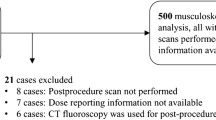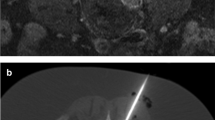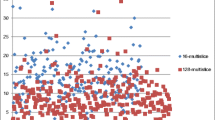Abstract
Objective
To evaluate the success rate of a low-dose (50 % mAs reduction) computed tomography (CT) biopsy technique. This protocol was adopted based on other successful reduced-CT radiation dose protocols in our department, which were implemented in conjunction with quality improvement projects.
Materials and methods
The technique included a scout view and initial localizing scan with standard dose. Additional scans obtained for further guidance or needle adjustment were acquired by reducing the tube current-time product (mAs) by 50 %. The radiology billing data were searched for CT-guided musculoskeletal procedures performed over a period of 8 months following the initial implementation of the protocol. These were reviewed for the type of procedure and compliance with the implemented protocol. The compliant CT-guided biopsy cases were then retrospectively reviewed for patient demographics, tumor pathology, and lesion size. Pathology results were compared to the ultimate diagnoses and were categorized as diagnostic, accurate, or successful.
Results
Of 92 CT-guided procedures performed during this period, two were excluded as they were not biopsies (one joint injection and one drainage), 19 were excluded due to non-compliance (operators neglected to follow the protocol), and four were excluded due to lack of available follow-up in our electronic medical records. A total of 67 compliant biopsies were performed in 63 patients (two had two biopsies, and one had three biopsies). There were 32 males and 31 females with an average age of 50 (range, 15–84 years). Of the 67 biopsies, five were non-diagnostic and inaccurate and thus unsuccessful (7 %); five were diagnostic but inaccurate and thus unsuccessful (7 %); 57 were diagnostic and accurate thus successful (85 %). These results were comparable with results published in the radiology literature.
Conclusions
The success rate of CT-guided biopsies using a low-dose protocol is comparable to published rates for conventional dose biopsies. The implemented low-dose protocol did not change the success rate of CT-guided musculoskeletal biopsies.



Similar content being viewed by others
References
Brink BA, Amis ES. Image wisely: a campaign to increase awareness about adult radiation protection. Radiology. 2010;257:p601–602.
Goske MJ, Appelgate KE, Boylan J, Butler PF, et al. The image gently campaign: working together to change practice. AJR. 2008;190(2):273–4.
Lee CS, Lewin JS, Nagy P. Events that have shaped the quality movement in radiology. JACR. 2012;8(8):p437–439.
State of California, Health and Human Services Agency, California Department of Public Health. Information Notice Regarding California Health and Safety Code, Section 115111, 115112, and 115113. http://www.cdph.ca.gov/certlic/radquip/Documents/AB510-FAQ.pdf
Ciaschini MW, Remer EM, Baker ME, Lieber M, et al. Urinary calculi: radiation dose reduction of 50 % and 75 % at CT—effect on sensitivity. Radiology. 2009;251(1):105–11.
Heneghan JP, McGuire KA, Leder RA, DeLong DM, et al. Helical CT for nephrolithiasis and urolethiasis: comparison of conventional and reduced radiation-dose techniques. Radiology. 2003;229(2):575–80.
Karmazyn B, Frush DP, Appelgate KE, Maxfield C. CT with a computer-simulated dose reduction technique for detection of pediatric nephroureterolithiasis: comparison of standard and reduced radiation doses. AJR. 2009;192:p143–149.
Yao L, Nelson SD, Seeger LL, Eckardt JJ, et al. Primary musculoskeletal neoplasms: effectiveness of core-needle biopsy. Radiology. 1999;212(3):682–6.
Omura MC, Motamedi K, UyBico S, Nelson SD, Seeger LL. Revisiting CT-guided percutaneous core needle biopsy of musculoskeletal lesions: contributors to biopsy success. AJR. 2011;197(2):p457–61.
Smith JC, Jin DH, Watkins GE, et al. Ultra-low-dose protocol for CT-guided lung biopsies. J Vasc Radiol (US). 2011;22(4):431–6.
Grasso RF, Cazzato RL, Luppi G, D’Agostino F, et al. Percutaneous lung biopsies: performance of an optical CT-based navigation system with a low-dose protocol. Eur Radiol. 2013;23:3071–6.
Taylor ML, Korn T. Consideration of the radiation dose delivered away from the treatment field to patients in radiotherapy. J Med Phys. 2011;36(2):p 59–71.
Patel AS, Soares B, Courtier J, Mackenzie JD. Radiation dose reduction in pediatric CT-guided musculoskeletal procedures. Pediatr Radiol. 2013;43(10):1303–8.
Conflict of interest
The authors have no conflicts of interest to disclose.
Author information
Authors and Affiliations
Corresponding author
Rights and permissions
About this article
Cite this article
Motamedi, K., Levine, B.D., Seeger, L.L. et al. Success rates for computed tomography-guided musculoskeletal biopsies performed using a low-dose technique. Skeletal Radiol 43, 1599–1603 (2014). https://doi.org/10.1007/s00256-014-1892-8
Received:
Revised:
Accepted:
Published:
Issue Date:
DOI: https://doi.org/10.1007/s00256-014-1892-8




